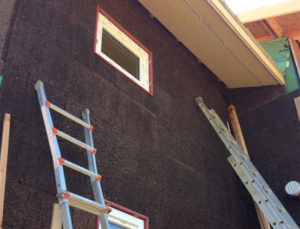News & Insights
Progress Report: Passive House
We have some great news: The G. Christianson Passive House is now PHIUS+ 2015 Pre-Certified, and PHIUS+ Source Zero Pre-Certified! This means that the solar panels on the garage provide all of the power for the house and proves that the house will use the amount of energy that the design predicted.
Passive House building is an exceptional way of reducing energy use of a home by 70% or more. Passive House building is supremely comfortable, has a healthy indoor environment, has a resilient and durable structure, and has an extremely low utility cost with a reduced carbon footprint. This is the best path to a NET ZERO or Positive Energy house. We will accomplish this by using the following techniques:
1. Install super insulation
2. Create air tightness with a fresh air ventilation system
3. Eliminate thermal bridges
4. Install exgtremely high performance windows and doors
5. Optimize Solar heat gain design through 3D building modeling
Project Update
Framing is complete at the G. Christianson Passive House, and work has begun on interior details. Our team took a trip to the house to perform a blower door test before drywall work closes up access to the stud bays of the walls. A blower door test detects the amount of air pressure that leaks through any cracks or gaps. A standard new house leaks between 3-5 air changes per hour under pressure. A Passive House requires that the home be no more than 0.6 air changes per hour. The G. Christianson Passive House tested at 0.29 air changes per hour – less than half of what our goal was! We’re moving forward with a strong number under our tool belts.
There are a lot of aspects of this house that are unconventional – and we expect to see these building techniques become the new normal. The foundation was upgraded to meet Fire Station Seismic Code levels. We framed 8″ thick walls, which allows for R-29 blown-in fiberglass insulation. In comparison, standard building code requires R21. We are also installing a 2″ layer of sustainable-harvested cork to the exterior of the home, which will go underneath the siding. The added exterior insulation provides a layer of breathe-ability and an additional value of R8 insulation.

[Photos: A Zehnder Fresh Air heat recovery ventilator, which brings fresh air to each room year-round; cork insulation on the exterior of the house; blower door test; interior stair framework].
The next phase of building is to install roofing, which is a copper-colored standing-seam metal roof – and one of Carl’s favorite design aspects of the home. The siding is Hardie panel siding with Boral trim. Simultaneously, we are working inside installing the drywall and getting ready for finishes like flooring, tile, and custom cabinetry.
Check in soon for our final photos of the first Passive House to be built in Corvallis. Please call us at 541-754-6326 if you would like a tour of this project.






